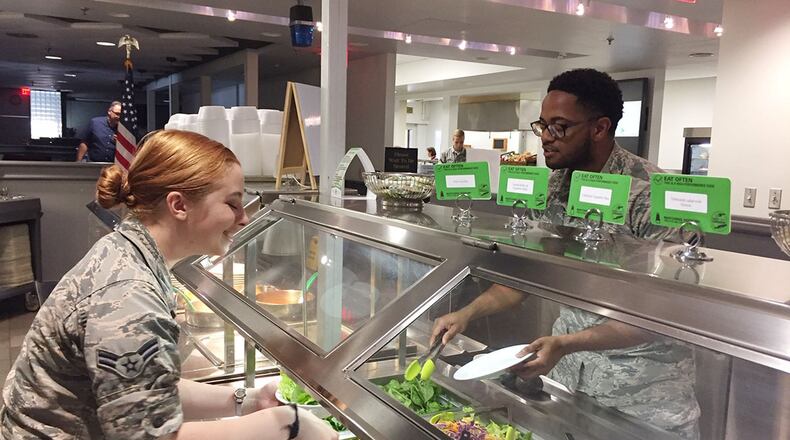“Everything is aimed at a healthier lifestyle,” said Staff Sgt. Steven Johnson, food service accountant. “I’ve seen a big change.”
Sodium-laden, high-fat foods are being replaced by better choices.
A popular choice is the “pure food” salad bar, which offers 26 items, including whole grain-based specialty salads like barley and quinoa, made from scratch on-site. Traditional salad bar vegetables and dressings have been joined by red wine vinegar and olive oil; roasted tofu, mushrooms, cauliflower and broccoli; grilled chicken and sweet potatoes; feta cheese; whole nuts like pecans and almonds; and sunflower and sesame seeds. Various fruits also have a prominent place.
A second improvement are color-coded cards in either red, yellow or green – resembling a stoplight – that are placed in front of hot foods in the cafeteria-style lines and help Airmen make more educated food choices. The Go For Green – G4G – program is a joint service performance-nutrition initiative that improves the food environment where service members live and work.
G4G prompts better food and beverage selections with the aim to optimize performance, readiness and health, according to the Human Performance Resource Center’s website.
“Red is what you’d want to eat rarely because they are low-fiber, low-nutient, more processed food; yellow is to eat occasionally because they indicate moderate fiber; and obviously green is what you’d eat most often because they are high-fiber, low fat, low sugar selections,” Vogel said.
The Air Force partnered with dieticians at the Culinary Institute of America to enhance the card program by indicating high, moderate and low sodium foods, he said. Such information is important to Airmen, Vogel continued.
“If an Airman is out in the field working strenuously and perspiring, they need more sodium,” he said.
Moderate and low levels of activity would require less sodium.
“As our days in food service go forward, the role of the dietician becomes more important,” Vogel noted.
Interestingly, menus are planned for a 28-day cycle at Air Force bases world-wide.
“Whatever we’re serving here is being served at Robins Air Force Base, Tinker Air Force Base and (on Air Force bases) everywhere else in the world,” he said.
Vogel uses a software program to compile useful data and track items. Airmen’s food choices can be tracked by their meal cards; such information can be given to dieticians from the 88th Medical Group if an Airman becomes a patient requiring care.
Pitsenbarger’s serving lines also follow the G4G program. They are organized to serve green card items first, then yellow, then red at the end. The strategy works, Johnson said.
“By the time you get to the end of the line to the less healthy choices, your plate is already full,” he said.
Burgers and French fries still have their place on a separate serving line, but their consumption by Airmen continues to trend downward, Vogel noted.
“I’ve been doing this for 10 years,” he said, “and when I look back a decade, I can tell you today’s Airmen are leaner and fitter. We try to go above and beyond for the Airmen while staying on budget and producing little waste.”
The fruit being offered is a good example of that. The Air Force requires that bananas, apples and oranges be available at every meal; the Pitsenbarger food service contractor adds seasonal items like whole avocado, pears and kiwi, plus watermelon and other melons from a cooling stand.
Airmen appreciate what is being served, and those living in the dormitories in Kittyhawk Center are regularly surveyed to see what they would like to see served. Smoothies, avocados and other foods are now being served because of them.
“The food is always really good,” said Airman 1st Class Jordan Ferrer, National Air and Space Intelligence Center. “I like the variety of foods from different cultures. I like being exposed to them.”
Airman 1st Class Anthony Streichert, also of NASIC, complemented his grilled chicken with vegetables on a plan to lose weight. The color-coded G4G cards help him make more educated choices, he said.
Johnson said he hopes to work with units to bring nutrition information to service members working to improve performance on their physical fitness tests.
“They could look at exactly what their Airmen are eating; if Airmen want to lose weight to help pass their test, that could be a help to them,” he said.
About the Author
